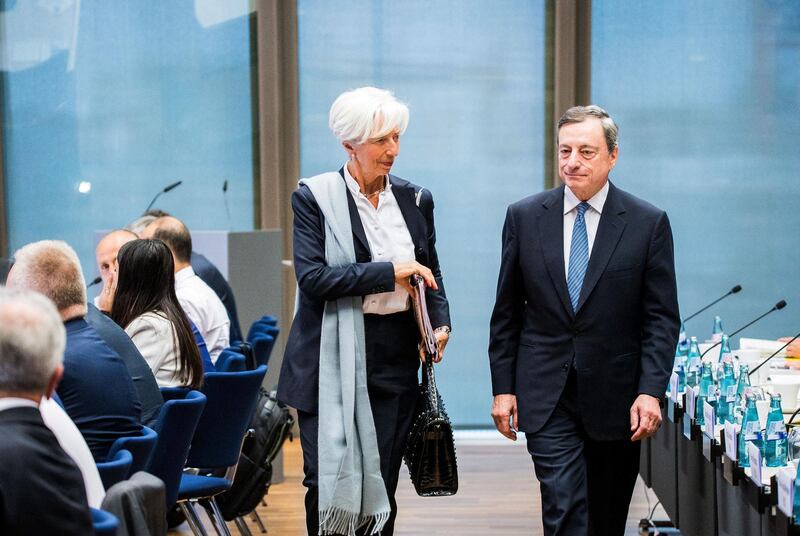Mario Draghi is entering the final three months of his European Central Bank presidency with a plan that will see his influence linger well after he’s replaced by Christine Lagarde.
The ECB chief will this week lead a policy meeting that’s widely expected to set the stage for a September interest-rate cut and a possible resumption of quantitative easing. His staff have also started work on a potential revamp of the inflation goal in a move that could make it easier to pursue monetary stimulus for longer.
It’s a bold strategy at the end of a term that has been defined by radical measures, and it could tie Lagarde’s hands well into her own eight-year tenure. Yet with inflation persistently below the ECB’s target despite years of massive stimulus, and with the economy now stuttering once again, Mr Draghi is likely to have her tacit endorsement.
“Draghi is trying to make sure that everything is in place for Lagarde when she comes in and to protect her from spending too much political capital too early,” said Axa chief economist Gilles Moec, a former Bank of France official. “It’s a case of taking one for the team in a way.”
Mr Draghi’s pressing concern as his October 31 end-date approaches, with only three policy meetings remaining, is that his €2.6 trillion (Dh10.71tn) of quantitative easing, negative interest rates and long-term bank loans have failed to sustainably reignite inflation.
Consumer-price growth has average just 1.2 per cent during his term - well under the goal of “below but close to 2 per cent” - and he’ll leave office never having tightened policy in his eight years in charge.
Economists surveyed by Bloomberg overwhelmingly expect the Governing Council to adjust its policy language at the July 25 meeting to signal that another cut in the deposit rate is coming, and to reduce the rate by 10 basis points to minus 0.5 per cent after the summer break. Some forecast another reduction in December, and just over half predict QE will be restarted, which would keep pumping in stimulus for at least several months.
Meanwhile, ECB staff are studying whether the inflation goal needs to be adjusted to be more effective. Mr Draghi favours a specific 2 per cent target with a “symmetric” approach, according to sources. That would allow the Governing Council to keep inflation elevated for a while after a period of weakness to ensure price growth is entrenched.
Investors - in financial markets and the real economy - will likely welcome the continuity that the president is apparently trying to lock in. A slowdown wrought by US-driven trade tensions and structural shifts in the manufacturing sector have left Europeans with little appetite for higher borrowing costs any time soon.
Central banks around the world have turned to looser policy. The US Federal Reserve is widely expected to cut rates a week after the ECB meeting with senior officials stressing the need to act quickly. South Korea and South Africa already eased policy last week.
Ms Lagarde, who was named as head of the International Monetary Fund in 2011 just four days after Mr Draghi was appointed to lead the ECB, has repeatedly praised central banks for their stimulus measures.
She’s also aware of the global struggle to revive inflation in developed economies. In the IMF’s home of Washington, the Fed is examining its own approach to its 2 per cent objective. Ms Lagarde’s former IMF chief economist Olivier Blanchard is an advocate of raising inflation targets to 4 per cent.
The ECB’s Governing Council is likely to consider this week how far it can go with stimulus. Negative interest rates are already hurting banks, a key channel for monetary policy, so another cut may require mitigation measures such as exemptions for some deposits. A resumption of QE may involve changing the central bank’s own rules on how much government debt it can buy, a move that could invite lawsuits.
Still, few ECB watchers doubt that the president and his successor are on essentially the same page.
“There is a good deal of continuity here,” said Nick Kounis, an economist at ABN Amro in Amsterdam.
“Lagarde is very much a believer in what the ECB has done so far, and maybe if anything she would be even more proactive and activist.”







